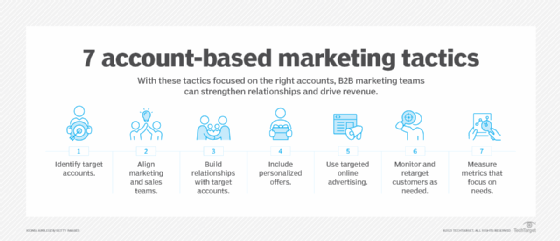7 account-based marketing tactics for your business
You can grow business revenue through an effective ABM strategy the complements lead-generation efforts. Here are 7 tactics to make your ABM program effective.
As B2B marketers strive to improve their overall marketing efforts, many embrace account-based marketing as an ideal complement to lead-generation efforts focused on driving long-term revenue growth. Let's look closer at ABM benefits and some tactics organizations can use in their marketing strategy.
What is account-based marketing?
Account-based marketing (ABM) is a B2B marketing tactic that focuses on key target accounts from the outset, as opposed to starting with a broad audience that's narrowed down as it progresses through the sales funnel. Using ABM allows for more personalized campaigns from the beginning.
ABM's goal is to treat an organization's key accounts individually, as a "market of one," through personalized one-to-one experiences and tailored content supported by a company's product offerings. ABM strives to improve pipeline quality, retention efforts and revenue across key accounts. By using an ABM approach, an organization strengthens customer relationships while complementing traditional lead-generation efforts.
Benefits of account-based marketing
Among the many benefits of ABM are the following:
- Increased marketing efficiency. By aligning sales and marketing teams and focusing on fewer accounts, sales and marketing efforts are streamlined, reducing the cost of acquiring new customers. ABM's focused approach also means marketing and customer success teams can consistently measure campaigns to improve ROI and accelerate the customer sales cycle.
- Efforts are more personalized and targeted. Addressing the customer's needs, which ABM does, should result in an improved sales cycle and enhance the business relationship.
- Higher ROI. ABM helps companies improve their ROI through focused efforts on higher-value accounts, especially when those companies align with the company's business goals.
- Higher engagement. ABM contributes to more effective lead generation and customer engagement, especially when employing personalized target approaches.
- Sales and marketing alignment. For ABM, close alignment between sales and marketing benefits the customer through increased efficiency.
- Customer retention. ABM contributes to effective lead generation and improved customer retention by focusing on high-value accounts that align with business goals. In addition, by channeling marketing efforts on key accounts -- i.e., those that drive revenue -- time and marketing spend are optimized. Furthermore, less-valuable customers are weeded out earlier so that engaging more critical customers is the focus.
The following are some content-focused tactics for ABM:
- Know who your target audience is and develop prospective-specific content.
- Know the kind of content that your target audience wants.
- Develop offers that are designed to be beneficial to your target audience.
- Personalize the account's experience, and test the content out with executives.
- Draft marketing tactics that work for you and your customers.
- Make sure your sales enablement content is customized.
- Create one-to-one, executive-level campaigns focused on the customer's needs.
Let's look at these in more detail.

7 account-based marketing tactics
- Identify target accounts. Analyze your current customer base and identify the characteristics of your most valuable customers. Here, an analysis can be used to identify the accounts aligned with your product or service. Using this list, content across channels can be personalized to speak to them and their needs. And finally, you can engage with key decision-makers to build relationships that speak to their needs.
- Align marketing and sales teams. Alignment can begin with a customer persona -- essentially, a shared understanding of who the target customer and accounts are and of the goals of the ABM program. The team should have a clear RACI across groups -- that is, they should know who is responsible, accountable, consulted and informed. They should also have an engagement model to establish how the team will collaborate and communicate with one another. Employing this approach ensures there is alignment across the groups.
- Build relationships with buyers from target accounts. This process begins with personalized content creation that has targeted messaging and speaks to buyers' direct needs and interests.
- Include personalized offers. Begin by creating targeted content and messaging for the customer and their needs. Offers are a different thing. Here, data analytics comes into play to identify the products or services that speak specifically to the customer's needs and wants, in order to create relevant, personalized content and offers.
- Use targeted online advertising. This tactic is about creating ads tailored to a customer's needs. It involves using data analytics to identify which channels are most effective to target and then advertising to those key accounts. This should result in reaching these accounts with a timely message that appeals to the customer, which increases the effectiveness of your ABM program.
- Monitor and retarget customers as needed. This approach uses performance tracking to identify strengths and opportunities to improve customer advertising.
- Measure metrics that focus on customers' needs. Home in on your customer feedback and KPIs to help identify areas of improvement.
An ideal complement to lead-generation efforts, ABM can help drive long-term revenue growth through its focus on key accounts, along with the application of targeted marketing approaches and personalization. With the adjustment of marketing efforts as needed, ABM keeps customers and their needs front and center.
Editor's note: TechTarget offers ABM and project intelligence data, tools and services.







